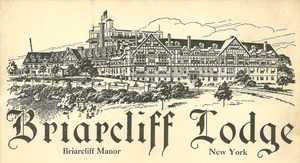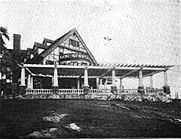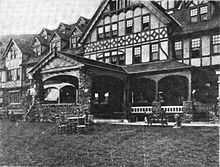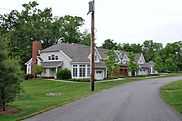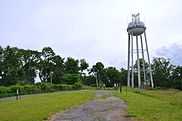Briarcliff Lodge
| Briarcliff Lodge | |
|---|---|
|
Early 1900s postcard of the Briarcliff Lodge | |
| General information | |
| Status | Demolished |
| Type | Resort |
| Architectural style | Tudor Revival |
| Address | 25 Scarborough Road |
| Town or city | Briarcliff Manor, New York |
| Country | United States |
| Coordinates | 41°08′53.2″N 73°50′23″W / 41.148111°N 73.83972°W |
| Opening | June 26, 1902 |
| Destroyed | January 16, 2004 |
| Owner |
|
| Technical details | |
| Floor count |
4 (original and north wing) 7 (west wing) |
| Design and construction | |
| Architect |
Guy King (1902) John Clark Udall (1907–09) |
The Briarcliff Lodge was a luxury resort in the village of Briarcliff Manor, New York. It was a notable example of Tudor Revival architecture, and was one of the largest wooden structures in the United States. It was also the first hotel in Westchester County.[1] Walter William Law had it built on his estate, and the Law family owned it until 1937. When the lodge opened in 1902, it was one of the largest resort hotels in the world. The lodge hosted presidents, royalty, and celebrities, and was the scene of numerous memorable occasions for visitors and local residents who attended weddings, receptions, and dances in the ballroom and dining room. For a long time, the lodge was situated among other businesses of Walter Law, including the Briarcliff Farms and Briarcliff Table Water Company.
In 1933, the lodge ended year-round service and housed a "health-diet sanitarium" until the Edgewood Park School for Girls began operation there from 1937 to 1954. From 1936 to 1939, the lodge was run again as a hotel in the summer months while the school was closed. From 1955 to 1994, The King's College used the lodge building and built dormitories and academic buildings. Abandoned and unmaintained after 1994, the Briarcliff Lodge was destroyed between 2003 and 2004.
History
.png)
Walter Law hired Pennsylvania architect Guy King to construct the Briarcliff Lodge on the highest point of Law's estate. The building's first floor exterior walls were constructed of stones from nearby forests, and Indiana limestone was used for trimmings. the second floor exterior walls were decorated with half timber with pebbledash. The roof had red shingles and red brick chimneys. At its June 26, 1902 opening, the Tudor Revival-style building was a premier resort hotel with approximately 75 rooms. The main facade of the building was two stories high, while third and fourth floor dormer windows were present on the roof. The Olmsted Brothers, sons of the eminent landscape designer Frederick Law Olmsted, designed the lodge's surrounding grounds. In 1903, the lodge additionally began being used by Mary Elizabeth Dow as Mrs. Dow's School. Walter Law gave Dow a 35-acre (14 ha) property on Elm Road (later the site of Briarcliff College and then a Pace University campus).[2]
In 1907, John Clark Udall oversaw construction of a north wing, increasing the number of rooms to 150. In 1909, Udall oversaw a 72-room seven-story west wing, further increasing the rooms to 221. The west wing had a mooring mast intended for airships, although no record exists of it having been used. The mooring mast nonetheless was the first built for docking airships. There were two sets of greenhouses near the property; one set behind Law's home produced decorations for Law's Briarcliff Farms, his house, the lodge, and workers' houses. The other set, the Pierson Greenhouses, were used for growing the American Beauty rose and rare carnations, producing between 5,000 and 8,000 per week. Foreman George Romaine first propagated the Briarcliff rose there. The lodge also ran an annual American Beauty carnival, with events including a golf tournament, water sports, moonlight bathing and night diving, a dinner dance, cinema program, and a concert.[3] During the lodge's service, carriage transportation was provided for guests from the Scarborough and Briarcliff Manor train stations to the lodge.[2]
The lodge had a large Roman-style pool; when it was built in 1912, it was the largest outdoor pool in the world[4] and was used for the 1924 Olympic trials.[5] The Briarcliff Lodge was noted for its cuisine (including Briarcliff dairy and table water), a golf course, fifteen tennis courts, a music room, theater, indoor swimming pool (measuring 30 by 70 feet, with a depth of 4 to 10 feet[2](p33)), casino, library, stable, repair shops and a fleet of Fiat automobiles.[6] The water tower at the property was constructed by the Chicago Bridge & Iron Company. The grounds were decorated with Japanese lanterns that Law had obtained from missionaries. The lodge had elevator service and electric lighting.[2] The Carnegie Endowment for International Peace held its National Conference on International Problems and Relations at the Briarcliff Lodge from May 10–14, 1926.[7]
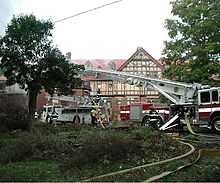
In 1923, a year before Walter Law's death, the Law family leased the lodge to Chauncey Depew Steele for 20 years. Under Steele's management, the lodge reached its prominence. The lodge also was opened to a wider variety of clientele, but continued to be known as a resort for the wealthy and famous. A 6,500-yard (5,900 m) 18-hole golf course was completed in 1923, designed by Devereux Emmet.[2] In May 1925, The New York Times reported that the Briarcliff Lodge installed the first artificial spa; using radioactive mineral torbernite to affect the water, believed to counter ailments associated with old age. Unites States Senators Chauncey Depew, James Wolcott Wadsworth, Jr., and Royal S. Copeland were to each place a bag containing the minerals into the lodge's swimming pool.[8] In June of that year, the newspaper mentioned in its report of an upcoming Briarcliff Lodge performance that the swimming pool was popular in the summer heat and that "the cool spring radioactive water gave considerable relief to several hundred guests".[9]
The hotel declined during the 1930s. Walter Law's son Henry (also village mayor from 1918 to 1938) attributed the decline to the 1920-1933 prohibition of alcohol. Another factor was the increasing usage of automobiles, as guests would be less inclined to stay throughout the summer. Steele ended up surrendering his lease in 1933;[2] at the time the building was valued at $750,000 ($13.7 million today[10]).[11] The lodge remained in use, housing a "health-diet sanitarium" until the Edgewood Park School for Girls, a nonsectarian Christian college- and occupational-preparatory school,[5](pp73-4) leased the property in 1936, and purchased it a year later; at the time the lodge was valued at $1,000,000 ($16.4 million today[10]).[12] The lodge was run as a hotel in the summer months while the school was closed until 1939. The Edgewood Park School operated there until 1954.[2]
In September 1955, The New York Times reported that the lodge was being reopened as a 225-room resort; after being purchased by a partnership led by Emanuel Shapiro, counsel for then-New York Governor Thomas E. Dewey. It was assessed at $400,000 ($3.52 million today[10]) at the time.[13]
From 1955 to 1994, The King's College, a strictly Fundamentalist coeducational liberal arts college,[14] relocated to the Briarcliff Lodge property. The school used the lodge building and built dormitories and academic buildings.[15][5] The New York State Board of Regents closed the school in 1994 due to financial difficulties and a deficiency of qualified faculty.[16] The original 1902 Briarcliff Lodge building burned to the ground on September 20, 2003 shortly before its scheduled demolition,[17] and contemporary portions of the lodge and other campus buildings were later demolished.[2]
The site will be developed as the Club at Briarcliff Manor, what The New York Times has described as "a super-luxury retirement community", with up to $2 million entrance fees. The Club was scheduled to open in 2013 and include tennis courts, a health spa, a Tudor-style clubhouse, gardens, a surround-sound theater, hiking trails, an indoor pool, a business center, a cocktail lounge, and multiple restaurants. As of 2010, 65 people have put down deposits, although the Club is planned to include 325 residences, including thirteen houses, 24 townhouses, and 288 apartments. Briarcliff Manor's village government took about five years to grant zoning changes, and several more years to approve the site plan.[18]
Notable guests
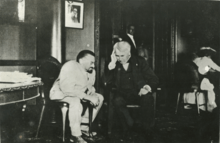
Franklin and Eleanor Roosevelt were guests at the Briarcliff Lodge. In the early 1930s, Eleanor spoke there several times on behalf of the Women's Democratic Club of Mount Pleasant; her daughter Anna Roosevelt Halsted was chairwoman of the club at the time. In 1930, Franklin spoke there as New York Governor to the Westchester County Bankers Association.[2]
John W. Davis, US Representative and nominee for President against Calvin Coolidge, visited the lodge in 1924.[19] US Senator Chauncey Depew visited in 1924 and 1927.[20][21] Composer and pianist Percy Grainger gave a recital at the ballroom of the lodge in 1925.[22]
Other notable guests have included Thomas Edison, Tallulah Bankhead, Sarah Bernhardt, Johnny Weissmuller, Jimmy Walker, Babe Ruth, Edward S. Curtis,[23] Thomas Edison, George B. Cortelyou, Mary Pickford, F. W. Woolworth, J. P. Morgan,[24][25][26] Warner Baxter, Vincent Richards, and Ernestine Schumann-Heink.[27](p32) Elihu Root, Al Smith, and a king of Siam were guests at the lodge in the 1920s, and John Campbell frequently hosted parties there.[2]
Influences
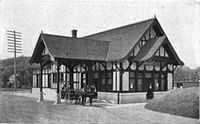
In 1906, Walter Law replaced the Briarcliff Manor railroad station and moved the original building to serve as Millwood's station. The new Briarcliff station, now part of the village library, was modeled in the style of his Briarcliff Lodge, and had Mission style furniture and rugs.[2] Central Briarcliff West is a neighborhood which has a number of mansions built by 20th-century millionaires who stayed at the Briarcliff Lodge and later built estates in the area. The Seven Sisters, a 1915 production, was filmed at the Briarcliff Lodge.[28]
See also
References
- ↑ Charles, Eleanor (May 17, 1987). "Westchester Guide". The New York Times. Retrieved November 24, 2014.
- ↑ 2.0 2.1 2.2 2.3 2.4 2.5 2.6 2.7 2.8 2.9 2.10 2.11 Yasinsac, Robert (2004). Images of America: Briarcliff Lodge. Charleston, South Carolina: Arcadia Publishing. ISBN 978-0-7385-3620-0. LCCN 2004104493. OCLC 57480785. OL 3314243M.
- ↑ "Westchester Folk Hold Horse Show". The New York Times. July 12, 1931. Retrieved November 24, 2014.
- ↑ Briarcliff Manor Centennial Committee (2002). The Briarcliff Manor Family Album: Celebrating a Century. Cornwall N.Y: Village of Briarcliff Manor.
- ↑ 5.0 5.1 5.2 Cheever, Mary (1990). The Changing Landscape: A History of Briarcliff Manor-Scarborough. West Kennebunk, Maine: Phoenix Publishing. ISBN 0-914659-49-9. LCCN 90045613. OCLC 22274920. OL 1884671M.
- ↑ Sharman, Karen (1996). Glory in Glass: A Celebration of The Briarcliff Congregational Church. ISBN 0-912882-96-4. OCLC 429606439.
- ↑ Catalog of Copyright Entries. New Series: 1926, Part 1. Library of Congress Copyright Office. 1927. p. 1386. Retrieved February 27, 2014.
- ↑ "To Begin Spa at Briarcliff". The New York Times. May 24, 1925. Retrieved November 24, 2014.
- ↑ "Mlle. Daisy Jean at Briarcliff Manor". The New York Times. June 14, 1925. Retrieved November 24, 2014.
- ↑ 10.0 10.1 10.2 Consumer Price Index (estimate) 1800–2014. Federal Reserve Bank of Minneapolis. Retrieved February 27, 2014.
- ↑ "Hotel Business Ends at Briarcliff Lodge". The New York Times. February 17, 1933. Retrieved November 24, 2014.
- ↑ "Briarcliff Lodge Sold For School". The New York Times. June 19, 1937. Retrieved November 24, 2014.
- ↑ "Briarcliff Lodge Sold". The New York Times. September 8, 1954. Retrieved November 24, 2014.
- ↑ "Briarcliff Lodge Turns a New Leaf". The New York Times. July 10, 1955. Retrieved November 24, 2014.
- ↑ Segal, David (February 20, 2008). "God and The City". The Washington Post (The Washington Post Company). Retrieved February 27, 2014.
- ↑ Bird, Warren (November 14, 1994). "State Closes King's College". Christianity Today. Retrieved November 20, 2014.
- ↑ "Our Village: a family place for more than a century". Briarcliff Manor-Scarborough Historical Society. Retrieved February 27, 2014.
- ↑ Arieff, Irwin (January 22, 2010). "Luxury Retirement Community Planned in Westchester". The New York Times. Retrieved January 30, 2015.
- ↑ "Coming to Briarcliff". Scarsdale Inquirer. August 2, 1924. Retrieved May 29, 2014.
- ↑ "Doings at Briarcliff". Scarsdale Inquirer. September 6, 1924. Retrieved May 29, 2014.
- ↑ "Depew at Briarcliff". Scarsdale Inquirer. July 22, 1927. Retrieved May 29, 2014.
- ↑ "Pianist to Play at Briarcliff". Scarsdale Inquirer. June 13, 1925. Retrieved May 29, 2014.
- ↑ "Briarcliff Lodge - Names of Many New Yorkers on the Hotel Registers". The New York Times. June 16, 1912. Retrieved February 27, 2014.
- ↑ Weinstock, Cheryl (April 2, 2000). "If You're Thinking of Living In/Briarcliff Manor; Small-Town Quality But Near Manhattan". The New York Times. Retrieved February 27, 2014.
- ↑ "Briarcliff Manor - Fall Programme of Outdoor Sports and Pastimes". The New York Times. September 5, 1909. Retrieved February 27, 2014.
- ↑ Leahy, Michael (1999). If You're Thinking of Living In...: All About 115 Great Neighborhoods In & Around New York. New York: Random House LLC. p. 282. ISBN 978-0-307-42107-4.
- ↑ Midge Bosak, ed. (1977). A Village Between Two Rivers: Briarcliff Manor. Monarch Publishing, Inc.
- ↑ "Film Made at Briarcliff". The New York Times. June 7, 1915. Retrieved November 24, 2014.
Further reading
- Yasinsac, Robert (2004). Images of America: Briarcliff Lodge. Charleston, South Carolina: Arcadia Publishing. ISBN 978-0-7385-3620-0. LCCN 2004104493. OCLC 57480785. OL 3314243M. For further information about the lodge and its history.
External links
| Wikimedia Commons has media related to Briarcliff Lodge. |
